中英双语传统故事教案
- 格式:docx
- 大小:3.47 KB
- 文档页数:3
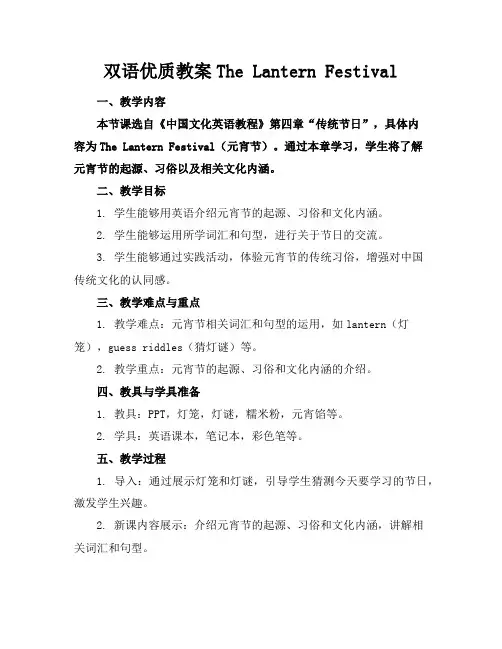
双语优质教案The Lantern Festival一、教学内容本节课选自《中国文化英语教程》第四章“传统节日”,具体内容为The Lantern Festival(元宵节)。
通过本章学习,学生将了解元宵节的起源、习俗以及相关文化内涵。
二、教学目标1. 学生能够用英语介绍元宵节的起源、习俗和文化内涵。
2. 学生能够运用所学词汇和句型,进行关于节日的交流。
3. 学生能够通过实践活动,体验元宵节的传统习俗,增强对中国传统文化的认同感。
三、教学难点与重点1. 教学难点:元宵节相关词汇和句型的运用,如lantern(灯笼),guess riddles(猜灯谜)等。
2. 教学重点:元宵节的起源、习俗和文化内涵的介绍。
四、教具与学具准备1. 教具:PPT,灯笼,灯谜,糯米粉,元宵馅等。
2. 学具:英语课本,笔记本,彩色笔等。
五、教学过程1. 导入:通过展示灯笼和灯谜,引导学生猜测今天要学习的节日,激发学生兴趣。
2. 新课内容展示:介绍元宵节的起源、习俗和文化内涵,讲解相关词汇和句型。
3. 实践活动:分组进行猜灯谜、制作灯笼、包元宵等活动,让学生在实践中体验元宵节的传统习俗。
4. 例题讲解:讲解关于节日的英语表达,如“How do you celebrate the Lantern Festival?”等。
5. 随堂练习:让学生运用所学知识,进行关于元宵节的对话练习。
六、板书设计1. The Lantern Festival2. 关键词:lantern, guess riddles, traditional customs, cultural connotations3. 重点句型:How do you celebrate the Lantern Festival?七、作业设计1. 作业题目:Write a short passage about the Lantern Festival, including its origin, customs and cultural connotations.2. 答案:The Lantern Festival, also known as Yuanxiao Festival, is a traditional Chinese festival celebrated on the 15th day of the first lunar month. It originated from the ancient ritual of lighting lanterns to worship the Moon Goddess. The festival is marked various activities, such as guessing riddles written on lanterns, making lanterns and eating sweet glutinous rice balls, or "yuanxiao". The Lantern Festival represents the unity and happiness of families, andis a symbol of the bright future and good fortune.八、课后反思及拓展延伸1. 课后反思:本节课通过实践活动,提高了学生对元宵节的了解和兴趣,达到了预期教学目标。
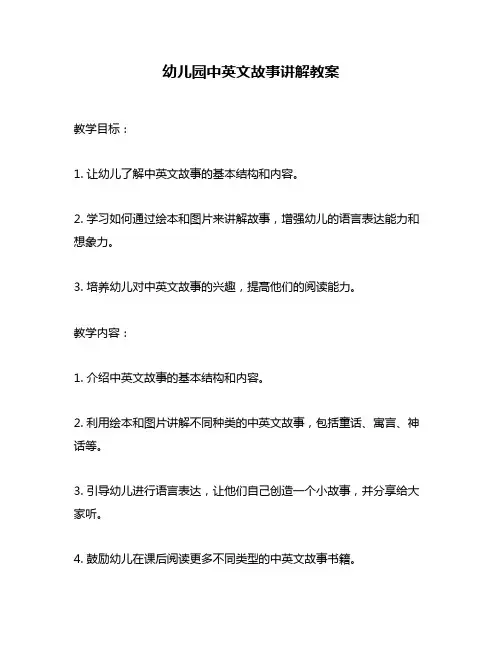
幼儿园中英文故事讲解教案教学目标:1. 让幼儿了解中英文故事的基本结构和内容。
2. 学习如何通过绘本和图片来讲解故事,增强幼儿的语言表达能力和想象力。
3. 培养幼儿对中英文故事的兴趣,提高他们的阅读能力。
教学内容:1. 介绍中英文故事的基本结构和内容。
2. 利用绘本和图片讲解不同种类的中英文故事,包括童话、寓言、神话等。
3. 引导幼儿进行语言表达,让他们自己创造一个小故事,并分享给大家听。
4. 鼓励幼儿在课后阅读更多不同类型的中英文故事书籍。
教学步骤:第一步:引入(1)老师出示一张童话绘本封面,并询问幼儿是否知道这是什么。
然后介绍童话的定义和特点,以及常见的童话人物角色(例如:公主、王子、巨人等)。
(2)老师出示一张寓言绘本封面,并询问幼儿是否知道这是什么。
然后介绍寓言的定义和特点,以及常见的寓言故事(例如:《小狗奶酪》、《葡萄与狐狸》等)。
(3)老师出示一张神话绘本封面,并询问幼儿是否知道这是什么。
然后介绍神话的定义和特点,以及常见的神话人物角色(例如:神、英雄、妖怪等)。
第二步:讲解(1)老师通过读绘本或展示图片来讲解一个童话故事,比如《灰姑娘》。
(2)老师通过读绘本或展示图片来讲解一个寓言故事,比如《小乌鸦喝水》。
(3)老师通过读绘本或展示图片来讲解一个神话故事,比如《夸父追日》。
第三步:语言表达(1)老师给幼儿一些提示词汇,比如“王子”、“公主”、“巨人”,鼓励他们自己创造一个小故事,并分享给大家听。
(2)在分享中,老师适当引导幼儿进行语言表达。
比如询问他们主角的名字、故事发生的地点和时间、发生了什么样的冲突以及如何解决等。
第四步:课后延伸(1)老师鼓励幼儿在课后阅读更多不同类型的中英文故事书籍,并分享自己的感受。
(2)老师可以为幼儿准备一个小册子,让他们在家中记录自己阅读的故事书目。
并鼓励他们在下次上课时分享其中一本书。
教学方法:1. 朗读法:通过朗读绘本来讲解故事。
2. 视觉法:通过展示图片来辅助讲解故事。
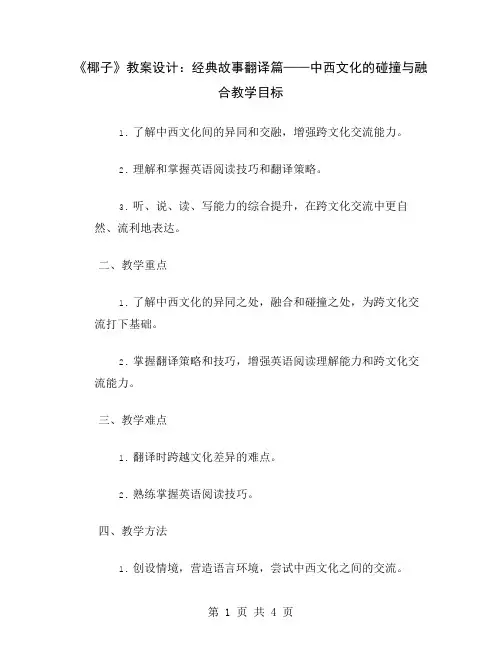
《椰子》教案设计:经典故事翻译篇——中西文化的碰撞与融合教学目标1.了解中西文化间的异同和交融,增强跨文化交流能力。
2.理解和掌握英语阅读技巧和翻译策略。
3.听、说、读、写能力的综合提升,在跨文化交流中更自然、流利地表达。
二、教学重点1.了解中西文化的异同之处,融合和碰撞之处,为跨文化交流打下基础。
2.掌握翻译策略和技巧,增强英语阅读理解能力和跨文化交流能力。
三、教学难点1.翻译时跨越文化差异的难点。
2.熟练掌握英语阅读技巧。
四、教学方法1.创设情境,营造语言环境,尝试中西文化之间的交流。
2.多媒体教学与小组互动,激发学生阅读兴趣和跨文化交流能力。
五、教学准备1.PowerPoint 课件2.版本:《椰子》中英版3.PPT制作软件4.语音素材下载5.实物小椰子。
六、教学过程一、引入(10分钟)在中西方文化交流中,语言和不同的文化和环境往是最大的障碍,而跨越这些障碍是我们面临未来挑战先决要解决的难题。
在这个过程中,翻译起着承上启下的作用。
今天我们要一起探究中西文化之间的异同和交融,学习英语阅读和翻译策略,提高跨文化交流能力。
二、阅读理解(15分钟)请以小组为单位,用英语阅读《椰子》的英版故事,并回答故事所提出的问题。
建议以 ppt 为辅助,让学生理解故事的主要情节。
三、解读与讨论(15分钟)1.请在 ppt 上解释故事中的一些词语和短语,并带领学生一起讨论其中的文化差异。
2.大胆发言,表达对中西文化交融的看法和自己的感受。
四、翻译练习(10分钟)请同学以小组为单位,分别翻译出《椰子》的中文版和英文版。
注意掌握好阅读和翻译的策略。
五、互动游戏小剧场(20分钟)请学生们在 ppt 上准备自己的角色扮演游戏,让大家在游戏中更加贴近故事情境,体验中西文化交流带来的魅力与乐趣。
建议邀请其他班级的同学和老师一起参与游戏。
六、课堂练习(10分钟)请同学们在 ppt 上完成课堂练习题,巩固学习成果。
请老师根据练习的答案及时讲解和反馈。
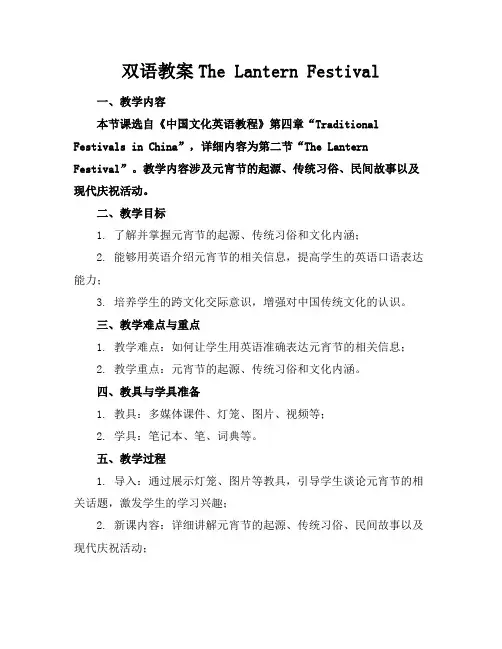
双语教案The Lantern Festival一、教学内容本节课选自《中国文化英语教程》第四章“Traditional Festivals in China”,详细内容为第二节“The Lantern Festival”。
教学内容涉及元宵节的起源、传统习俗、民间故事以及现代庆祝活动。
二、教学目标1. 了解并掌握元宵节的起源、传统习俗和文化内涵;2. 能够用英语介绍元宵节的相关信息,提高学生的英语口语表达能力;3. 培养学生的跨文化交际意识,增强对中国传统文化的认识。
三、教学难点与重点1. 教学难点:如何让学生用英语准确表达元宵节的相关信息;2. 教学重点:元宵节的起源、传统习俗和文化内涵。
四、教具与学具准备1. 教具:多媒体课件、灯笼、图片、视频等;2. 学具:笔记本、笔、词典等。
五、教学过程1. 导入:通过展示灯笼、图片等教具,引导学生谈论元宵节的相关话题,激发学生的学习兴趣;2. 新课内容:详细讲解元宵节的起源、传统习俗、民间故事以及现代庆祝活动;3. 实践情景引入:分组讨论,让学生用英语介绍自己家乡的元宵节习俗;4. 例题讲解:讲解如何用英语描述元宵节的习俗,如猜灯谜、吃元宵等;5. 随堂练习:让学生用英语编写一段关于元宵节的小对话;六、板书设计1. The Lantern Festival2. 主要内容:Origin of the festivalTraditional customsFolk storiesModern celebration activities七、作业设计1. 作业题目:Write a short essay about your favorite part of the Lantern Festival and why.2. 答案示例:八、课后反思及拓展延伸2. 拓展延伸:鼓励学生课下了解其他中国传统节日,用英语进行介绍,提高学生的跨文化交际能力。
重点和难点解析1. 教学难点:如何让学生用英语准确表达元宵节的相关信息;2. 实践情景引入:分组讨论,让学生用英语介绍自己家乡的元宵节习俗;3. 作业设计:Write a short essay about your favorite part of the Lantern Festival and why.一、教学难点解析1. 提供丰富的词汇和表达方式:为学生提供与元宵节相关的词汇、短语和句型,让他们在表达时有更多的选择。
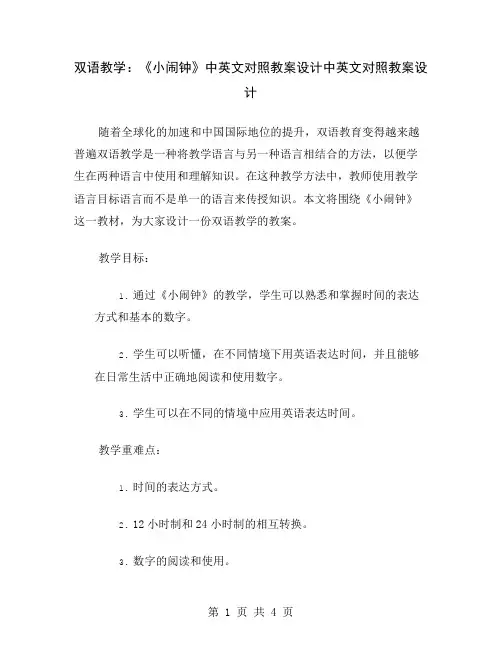
双语教学:《小闹钟》中英文对照教案设计中英文对照教案设计随着全球化的加速和中国国际地位的提升,双语教育变得越来越普遍双语教学是一种将教学语言与另一种语言相结合的方法,以便学生在两种语言中使用和理解知识。
在这种教学方法中,教师使用教学语言目标语言而不是单一的语言来传授知识。
本文将围绕《小闹钟》这一教材,为大家设计一份双语教学的教案。
教学目标:1.通过《小闹钟》的教学,学生可以熟悉和掌握时间的表达方式和基本的数字。
2.学生可以听懂,在不同情境下用英语表达时间,并且能够在日常生活中正确地阅读和使用数字。
3.学生可以在不同的情境中应用英语表达时间。
教学重难点:1.时间的表达方式。
2.12小时制和24小时制的相互转换。
3.数字的阅读和使用。
教学环节:引入1.通过数学课或儿歌《时钟儿走得慢》的介绍,引出时间这一话题。
2.引进《小闹钟》这一教材并介绍教材的目的和内容。
3.用数字习题来进行引进,如“用英语表述40分钟后是几点钟?”听力训练1.播放《小闹钟》视频,让学生先静听一遍,然后再听懂视频中的情节。
可以结合图片和实物时间表来扩展学生的理解和掌握。
2.播放M.Grammar教材中有关时间的教学视频,让学生针对不同情境下的时间询问和回答口语化程度的练习。
语音和发音训练1.口语训练:让学生大声朗读英语数字的发音,并帮助学生掌握它们的正确读法。
2.发音训练:遍枚举1到60间每一个数字,要求学生正确地朗读它的发音。
然后教师会指示学生用这些数字来表达时间。
写作训练1.要求学生阅读教材中的时间表,并自己用英文数字书写出来。
2.通过绘画和写作,让学生掌握并使用日常场景下的时间表达方式,以及在对话中的英语表示方法。
小结1.回顾本节课的主要内容,确认学生对课程的理解程度。
2.与学生一起总结目前为止学到的时间相关的英语知识。
3.结束课程。
练习1.请对以下时间进行英语表达。
如:2:45(没有半小时)2.答案:two forty-five。
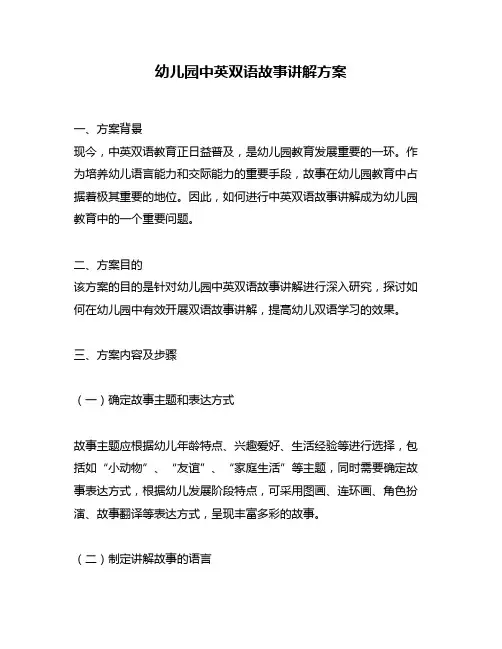
幼儿园中英双语故事讲解方案一、方案背景现今,中英双语教育正日益普及,是幼儿园教育发展重要的一环。
作为培养幼儿语言能力和交际能力的重要手段,故事在幼儿园教育中占据着极其重要的地位。
因此,如何进行中英双语故事讲解成为幼儿园教育中的一个重要问题。
二、方案目的该方案的目的是针对幼儿园中英双语故事讲解进行深入研究,探讨如何在幼儿园中有效开展双语故事讲解,提高幼儿双语学习的效果。
三、方案内容及步骤(一)确定故事主题和表达方式故事主题应根据幼儿年龄特点、兴趣爱好、生活经验等进行选择,包括如“小动物”、“友谊”、“家庭生活”等主题,同时需要确定故事表达方式,根据幼儿发展阶段特点,可采用图画、连环画、角色扮演、故事翻译等表达方式,呈现丰富多彩的故事。
(二)制定讲解故事的语言对于幼儿,中英双语故事讲解应根据他们的语言习惯和发展特点进行,采用易懂、简短、生动形象的语言,尽量避免使用难度较高的生僻字汇和复杂的语法结构,同时应注意口音等问题,保证故事表达的准确性和有效性。
(三)讲解故事流程与策略中英双语故事讲解流程应注重整体策略,包括赏析、讲述、评析三个阶段,以此确保幼儿听懂和理解故事,同时还需要注意一些细节策略,如动画、歌曲、角色扮演等。
1. 赏析阶段:通过展示故事图画、连环画等,向幼儿传达故事基本内容和主题,引起幼儿的好奇心。
2. 讲述阶段:通过口头表达、动作模仿等方式,以生动有趣的语言讲述故事内容,使幼儿真正感受到故事的情感和内涵。
3. 评析阶段:通过带领幼儿回顾故事内容、分析问题等方式,让幼儿及时检查自己的理解是否准确,最终达到增强记忆、强化语言能力等效果。
(四)中英双语故事讲解的技巧1. 确定固定时间:在一定的时间范围内进行故事讲解,准时开始,准时结束,使幼儿对于听故事保持一定的耐心和集中注意力。
2. 采用转换方式:在幼儿听不懂中文故事时,要用英文进行翻译,使幼儿建立中英文对应的意识,增强幼儿的双语能力。
3. 让幼儿参与其中:幼儿可以通过动手画图、拼接拼图等方式参与到故事讲解中,体验到和故事主人公一样的角色体验。
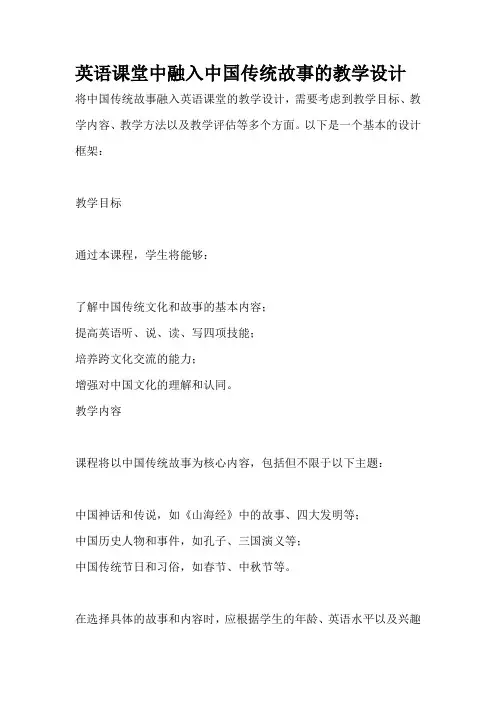
英语课堂中融入中国传统故事的教学设计将中国传统故事融入英语课堂的教学设计,需要考虑到教学目标、教学内容、教学方法以及教学评估等多个方面。
以下是一个基本的设计框架:教学目标通过本课程,学生将能够:了解中国传统文化和故事的基本内容;提高英语听、说、读、写四项技能;培养跨文化交流的能力;增强对中国文化的理解和认同。
教学内容课程将以中国传统故事为核心内容,包括但不限于以下主题:中国神话和传说,如《山海经》中的故事、四大发明等;中国历史人物和事件,如孔子、三国演义等;中国传统节日和习俗,如春节、中秋节等。
在选择具体的故事和内容时,应根据学生的年龄、英语水平以及兴趣进行筛选和改编。
故事应具有代表性和趣味性,能够吸引学生的注意力。
教学方法本课程将采用多种教学方法,包括:故事教学:通过讲述中国传统故事,帮助学生了解文化背景,提高英语听力理解能力;角色扮演:让学生扮演故事中的角色,用英语进行对话和表演,提高口语表达能力和自信心;阅读理解:通过阅读英文版的中国传统故事,提高学生的阅读理解能力和词汇量;写作练习:让学生用自己的语言复述故事或写读后感,提高写作能力。
教学评估本课程的评估将采用多种形式,包括:课堂表现:观察学生在课堂上的参与度和表现,给予及时的反馈和指导;小组讨论:让学生分享自己对中国传统故事的理解和看法,评估他们的思维能力和表达能力;书面作业:要求学生写读后感或复述故事,评估他们的写作能力和对故事的掌握程度。
以上是一个基本的教学设计框架,具体实施时还需要根据学生的实际情况进行调整和完善。
通过将中国传统故事融入英语课堂,不仅可以提高学生的英语技能,还可以增强他们对本土文化的理解和认同,培养他们的跨文化交流能力。
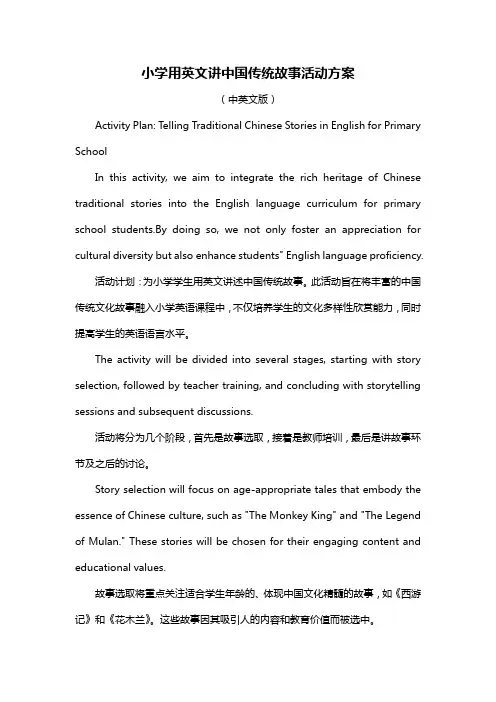
小学用英文讲中国传统故事活动方案(中英文版)Activity Plan: Telling Traditional Chinese Stories in English for Primary SchoolIn this activity, we aim to integrate the rich heritage of Chinese traditional stories into the English language curriculum for primary school students.By doing so, we not only foster an appreciation for cultural diversity but also enhance students" English language proficiency.活动计划:为小学学生用英文讲述中国传统故事。
此活动旨在将丰富的中国传统文化故事融入小学英语课程中,不仅培养学生的文化多样性欣赏能力,同时提高学生的英语语言水平。
The activity will be divided into several stages, starting with story selection, followed by teacher training, and concluding with storytelling sessions and subsequent discussions.活动将分为几个阶段,首先是故事选取,接着是教师培训,最后是讲故事环节及之后的讨论。
Story selection will focus on age-appropriate tales that embody the essence of Chinese culture, such as "The Monkey King" and "The Legend of Mulan." These stories will be chosen for their engaging content and educational values.故事选取将重点关注适合学生年龄的、体现中国文化精髓的故事,如《西游记》和《花木兰》。
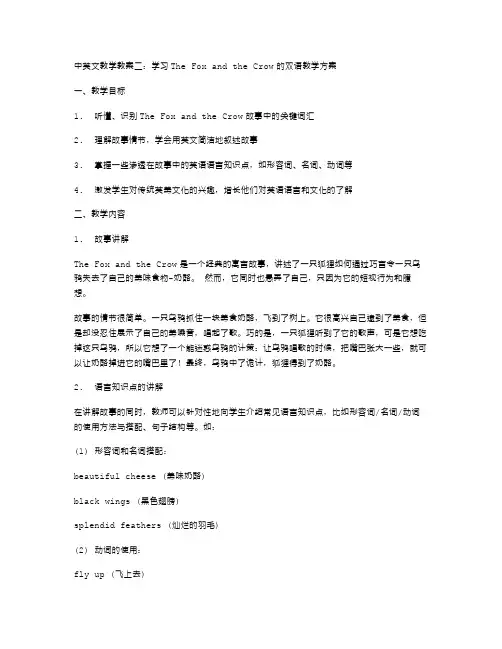
中英文教学教案二:学习The Fox and the Crow的双语教学方案一、教学目标1.听懂、识别The Fox and the Crow故事中的关键词汇2.理解故事情节,学会用英文简洁地叙述故事3.掌握一些渗透在故事中的英语语言知识点,如形容词、名词、动词等4.激发学生对传统英美文化的兴趣,增长他们对英语语言和文化的了解二、教学内容1.故事讲解The Fox and the Crow是一个经典的寓言故事,讲述了一只狐狸如何通过巧言令一只乌鸦失去了自己的美味食物-奶酪。
然而,它同时也愚弄了自己,只因为它的短视行为和臆想。
故事的情节很简单。
一只乌鸦抓住一块美食奶酪,飞到了树上。
它很高兴自己逮到了美食,但是却没忍住展示了自己的美嗓音,唱起了歌。
巧的是,一只狐狸听到了它的歌声,可是它想吃掉这只乌鸦,所以它想了一个能迷惑乌鸦的计策:让乌鸦唱歌的时候,把嘴巴张大一些,就可以让奶酪掉进它的嘴巴里了!最终,乌鸦中了诡计,狐狸得到了奶酪。
2.语言知识点的讲解在讲解故事的同时,教师可以针对性地向学生介绍常见语言知识点,比如形容词/名词/动词的使用方法与搭配、句子结构等。
如:(1) 形容词和名词搭配:beautiful cheese (美味奶酪)black wings (黑色翅膀)splendid feathers (灿烂的羽毛)(2) 动词的使用:fly up (飞上去)sing loudly (高声歌唱)talk sweetly (富有感染力地说话)(3) 句子结构和表达方式:The crow has some tasty cheese in her beak。
(乌鸦的嘴巴里含着美味的奶酪。
)The fox said sweet words to the crow. (狐狸对乌鸦说了动人的话。
)三、教学方法1.听说模式通过朗读故事、询问问题,鼓励学生表达自己的看法和想法,打造一个积极的英语学习环境。
2.互动教学引导学生多参与互动讨论、角色扮演和其他互动活动,增强英语学习的分组效应,让学生克服英语表达障碍和语感壁垒。
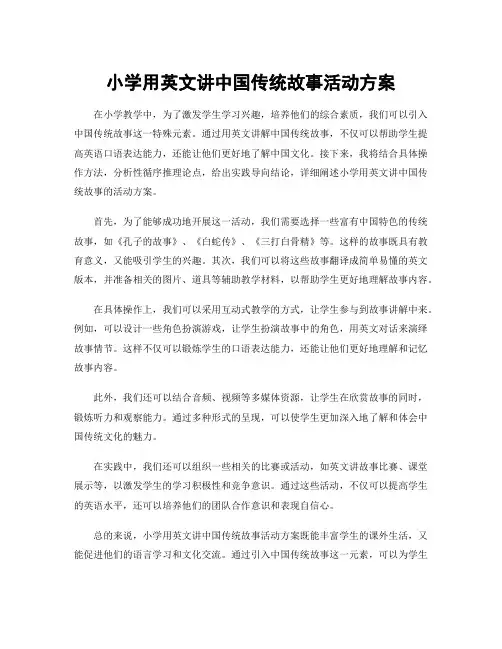
小学用英文讲中国传统故事活动方案在小学教学中,为了激发学生学习兴趣,培养他们的综合素质,我们可以引入中国传统故事这一特殊元素。
通过用英文讲解中国传统故事,不仅可以帮助学生提高英语口语表达能力,还能让他们更好地了解中国文化。
接下来,我将结合具体操作方法,分析性循序推理论点,给出实践导向结论,详细阐述小学用英文讲中国传统故事的活动方案。
首先,为了能够成功地开展这一活动,我们需要选择一些富有中国特色的传统故事,如《孔子的故事》、《白蛇传》、《三打白骨精》等。
这样的故事既具有教育意义,又能吸引学生的兴趣。
其次,我们可以将这些故事翻译成简单易懂的英文版本,并准备相关的图片、道具等辅助教学材料,以帮助学生更好地理解故事内容。
在具体操作上,我们可以采用互动式教学的方式,让学生参与到故事讲解中来。
例如,可以设计一些角色扮演游戏,让学生扮演故事中的角色,用英文对话来演绎故事情节。
这样不仅可以锻炼学生的口语表达能力,还能让他们更好地理解和记忆故事内容。
此外,我们还可以结合音频、视频等多媒体资源,让学生在欣赏故事的同时,锻炼听力和观察能力。
通过多种形式的呈现,可以使学生更加深入地了解和体会中国传统文化的魅力。
在实践中,我们还可以组织一些相关的比赛或活动,如英文讲故事比赛、课堂展示等,以激发学生的学习积极性和竞争意识。
通过这些活动,不仅可以提高学生的英语水平,还可以培养他们的团队合作意识和表现自信心。
总的来说,小学用英文讲中国传统故事活动方案既能丰富学生的课外生活,又能促进他们的语言学习和文化交流。
通过引入中国传统故事这一元素,可以为学生打开一扇了解中国文化的窗口,让他们在轻松愉快的氛围中学习和成长。
希望这些活动方案可以为教师们在教学实践中提供一些借鉴和启示。
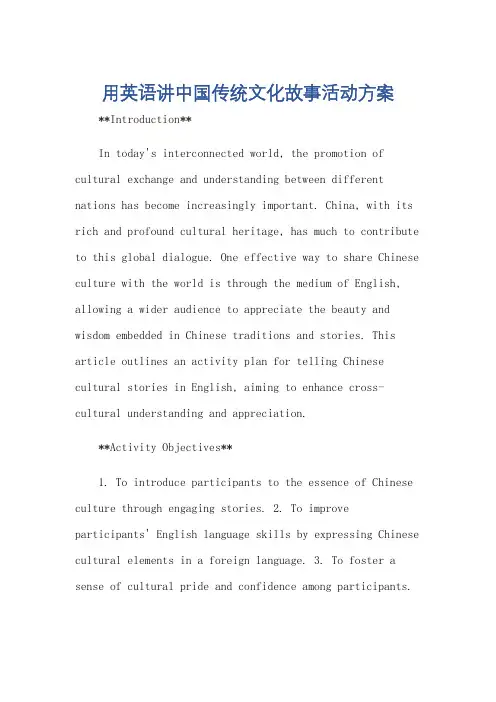
用英语讲中国传统文化故事活动方案**Introduction**In today's interconnected world, the promotion of cultural exchange and understanding between different nations has become increasingly important. China, with its rich and profound cultural heritage, has much to contribute to this global dialogue. One effective way to share Chinese culture with the world is through the medium of English, allowing a wider audience to appreciate the beauty and wisdom embedded in Chinese traditions and stories. This article outlines an activity plan for telling Chinese cultural stories in English, aiming to enhance cross-cultural understanding and appreciation.**Activity Objectives**1. To introduce participants to the essence of Chinese culture through engaging stories.2. To improveparticipants' English language skills by expressing Chinese cultural elements in a foreign language. 3. To foster a sense of cultural pride and confidence among participants.4. To promote international understanding and respect for Chinese culture.**Target Audience**This activity is suitable for a diverse audience, including English language learners, cultural enthusiasts, and those interested in expanding their knowledge of global cultures. It is particularly beneficial for young people as it helps them develop a global perspective and enhancestheir intercultural communication skills.**Activity Content**1. **Story Selection**: Carefully choose a variety of Chinese cultural stories that are both engaging and educational. These could include folklore, historical tales, or moral stories that reflect the values and wisdom of Chinese culture.2. **Storytelling Sessions**: Invite experienced storytellers or cultural experts to deliver the stories in English. This ensures that the stories are accurately translated and effectively communicated.3.**Interactive Discussion**: Encourage participants to ask questions and share their thoughts and interpretations ofthe stories. This interactive session fosters a deeperunderstanding and appreciation of the cultural messages behind the stories. 4. **Cultural Workshops**: Conduct workshops on specific aspects of Chinese culture, such as calligraphy, traditional music, or festival customs. These workshops provide participants with hands-on experiences that bring Chinese culture to life. 5. **Story Retelling**: Challenge participants to retell the stories they have heard in their own words. This activity not only enhances their English language skills but also allows them to internalize the cultural values and insights gained from the stories.**Activity Implementation**1. **Venue and Timing**: Choose a suitable venue, such as a community center or school auditorium, and schedule the activity during a time convenient for participants.2. **Promotion and Registration**: Utilize social media, flyers, and word of mouth to advertise the event and encourage participation. Set up a registration system to keep track of participants and ensure smooth event management.3. **Resources and Materials**: Prepare necessary resources such as storybooks, audio-visual aids,and cultural props to enhance the storytelling experience. 4. **Evaluation and Feedback**: Conduct a post-event evaluation to gather feedback from participants andidentify areas for improvement. Use this information to refine future iterations of the activity.**Conclusion**By telling Chinese cultural stories in English, we have the opportunity to bridge cultural divides and fostermutual understanding and respect between China and the rest of the world. This activity plan provides a framework for doing so effectively, ensuring that the rich tapestry of Chinese culture is accurately represented and deeply appreciated by a global audience.**用英语讲中国传统文化故事活动方案****引言**在当今世界日益互联的背景下,促进不同国家之间的文化交流与理解变得尤为重要。
双语教案The Lantern Festival一、教学内容本节课选自《汉语文化与交际》教材第四章“传统节日与文化”,详细内容为第三节“The Lantern Festival(元宵节)”。
教学内容主要包括元宵节的起源、习俗、意义及其在现代社会的影响。
二、教学目标1. 了解并掌握元宵节的起源、习俗及相关文化知识。
2. 能够运用所学知识进行简单的节日话题讨论,提高学生的口语表达能力。
3. 培养学生对中华传统文化的兴趣,增强文化自信。
三、教学难点与重点1. 教学难点:元宵节习俗的英文表达,以及节日背后的文化内涵。
2. 教学重点:掌握元宵节的基本知识,能够进行节日话题讨论。
四、教具与学具准备1. 教具:PPT、图片、视频、卡片等。
2. 学具:笔记本、笔、词典等。
五、教学过程1. 导入:通过展示元宵节的相关图片,引导学生谈论对元宵节的了解,激发学生的兴趣。
2. 新课内容:详细介绍元宵节的起源、习俗、意义等,结合PPT、视频等教具,让学生直观地感受节日的氛围。
a. 起源:介绍元宵节的起源,强调其与道教、佛教的关系。
b. 习俗:讲解元宵节的主要习俗,如赏花灯、猜灯谜、吃元宵等,并展示相关图片、视频。
c. 意义:阐述元宵节在传统文化中的地位,以及其在现代社会的影响。
3. 实践情景引入:设置一个节日庆祝活动,让学生模拟参与,提高口语表达能力。
4. 例题讲解:以元宵节为主题,设计一些练习题,帮助学生巩固所学知识。
5. 随堂练习:进行小组讨论,让学生运用所学知识进行节日话题讨论。
六、板书设计1. The Lantern Festival2. 内容:起源:道教、佛教习俗:赏花灯、猜灯谜、吃元宵意义:传统文化、现代社会影响七、作业设计1. 作业题目:a. 用英文介绍元宵节的起源和习俗。
b. 编写一个关于元宵节的小故事。
2. 答案:a. The Lantern Festival, also known as Yuanxiao Festival, has its origins in Taoism and Buddhism. The maincustoms include appreciating lanterns, guessing riddles, and eating yuanxiao (glutinous rice balls).b. (略)八、课后反思及拓展延伸2. 拓展延伸:鼓励学生深入了解其他传统节日,提高跨文化交际能力。
幼儿园中英文双语教育活动教案一、教学目标:1.能够听懂并朗读双语故事《三只小猪》。
2.能够运用双语语言描述不同材料建造的房子的特点。
3.培养幼儿的认知、观察、分析、判断和沟通能力。
二、教学重难点:1.双语故事的听懂和朗读。
2.不同材料建房子的特点描述。
3.培养幼儿的双语思维和语言表达。
三、教学准备:1.故事书《三只小猪》。
2.图片或实物:枝条、草、稻草、砖头等。
3.幼儿系鞋架和衣架。
四、教学步骤:Step 1:引入活动教师带着幼儿唱《小猪住房子》歌曲,激发幼儿对房子的兴趣,让幼儿明确房子的作用和功能。
Step 2:故事分享教师讲述双语故事《三只小猪》,教师在教学中要多表现大灰狼的威胁,给幼儿更直观的感受,强化幼儿的安全意识。
Step 3:分组互动教师将幼儿分组,让小组里的幼儿分别扮演小猪和大灰狼的角色,让幼儿更深刻地理解故事,巩固学过的内容。
Step 4:绘画表现教师给幼儿放一些不同材料的图片或实物,让幼儿描绘图片或实物,描述每种材料对建造房子的影响和特点。
Step 5:创意设计教师带领幼儿到幼儿系鞋架和衣架旁,让幼儿利用枝条、草、稻草、砖头等材料,设计自己心中理想的房子,增强幼儿对材料的认知和合作能力。
Step 6:展示交流教师让每个小组的幼儿展示自己创造的房子,分享自己对建房子的理解和感想,培养幼儿的表达和交流能力,同时给予肯定和鼓励。
五、教学评估:1.教师在教学中观察幼儿的学习表现和参与度,及时记录并评价。
2.教师从幼儿的角度出发,了解幼儿对故事、材料和建房子的理解和表达能力。
六、教学延伸:1.家园互动:教师将幼儿所创造的房子照片制成画册或集邮册,布置在班级角落,供家长和幼儿游览,让幼儿将学习成果分享给家人。
2.日常游戏:教师可以在日常活动中延伸之前学习的内容,例如:在操场上搭建房子,让幼儿通过游戏中体验学到更多的建造知识,并且能够巩固和深化学过的内容。
一、教学目标1. 知识目标:- 学生能够掌握一定的汉语词汇和语法知识。
- 学生能够听懂并说出基本的民汉双语对话。
- 学生能够阅读简单的民汉双语文章。
2. 能力目标:- 学生能够运用汉语进行日常交流。
- 学生能够运用民汉双语进行阅读和写作。
3. 情感目标:- 学生能够对民汉双语学习产生兴趣。
- 学生能够树立民族自豪感,增强跨文化交流能力。
二、教学内容1. 词汇:选取与学生生活、学习相关的词汇,如:学校、家庭、朋友、食物、天气等。
2. 语法:介绍基本的汉语语法知识,如:名词、动词、形容词、副词等。
3. 对话:设计日常生活中的民汉双语对话场景。
4. 阅读:选取适合学生水平的民汉双语文章。
三、教学过程1. 导入新课- 利用图片、视频等教学资源,引入新课主题。
- 引导学生复习上一节课的内容。
2. 新课讲解- 词汇讲解:通过实物、图片、动作等方式,帮助学生理解和记忆词汇。
- 语法讲解:结合具体例句,讲解语法知识,并让学生进行练习。
- 对话练习:设计情景对话,让学生进行角色扮演,锻炼口语表达能力。
3. 课堂活动- 小组讨论:将学生分成小组,围绕某一话题进行讨论,提高学生合作交流能力。
- 课堂游戏:设计趣味游戏,激发学生学习兴趣,巩固所学知识。
4. 课后作业- 完成课后练习题,巩固所学知识。
- 搜集民汉双语资料,了解民族文化。
四、教学评价1. 课堂表现:观察学生在课堂上的参与度、积极性、合作精神等。
2. 作业完成情况:检查学生课后作业的完成情况,了解学生对知识的掌握程度。
3. 口语测试:进行口语测试,评估学生的口语表达能力。
五、教学反思1. 教师在教学过程中,要关注学生的个体差异,因材施教。
2. 创设轻松、愉快的课堂氛围,激发学生学习兴趣。
3. 注重培养学生的实际运用能力,将所学知识应用于实际生活中。
以下为教案示例:课题:我的家庭一、教学目标1. 知识目标:- 学生能够掌握家庭相关词汇,如:父亲、母亲、哥哥、姐姐等。
双语教育教案:用《四名字里故事》培养孩子中英文口语交际能力在当今全球化的时代,双语教育越来越受到人们的重视,越来越多的家长开始考虑让孩子学习中英双语。
但如何培养孩子的中英文口语交际能力却是一个难题。
今天,我将介绍一种双语教育教案,即用《四名字里故事》来培养孩子中英文口语交际能力。
一、教学目标1.了解中英文的基本语音、字母、单词和短语。
2.培养孩子对汉语和英语语音的感知能力。
3.通过互动交流,提高孩子的口语表达能力。
4.通过故事学习,扩大孩子的词汇量。
二、教学准备1.《四名字里故事》故事书或电子书。
2.中英文单词卡片。
3.教学课件或白板。
三、教学流程1.课前导入通过问答、游戏等方式,激发孩子们的兴趣,让他们了解今天教学的主题。
2.教学重点介绍中英文的基本语音、字母、单词和短语,并演示正确的发音方法。
3.教学方法采用互动交流的方式,鼓励孩子们自由表达,以达到提高口语表达能力的目的。
4.教学过程1)故事学习通过阅读故事,扩大孩子们的词汇量,同时让他们了解中英文的语音差异。
例如,故事《兔子和熊猫》的中英文对照:故事中文版有一只兔子和一只熊猫。
兔子很有礼貌,总是叫熊猫“先生”。
可是熊猫总是叫兔子“小兄弟”,因为兔子比熊猫小。
故事英文版There is a rabbit and a panda. The rabbit is very polite and always calls the panda "sir". But the panda always calls the rabbit "little brother" because the rabbit is smaller than the panda.在阅读中,教师可以根据孩子们的掌握程度,适当补充一些单词和短语。
2)语音感知在故事学习和掌握基本单词后,教师可以抽出一些单词或句子,让孩子们用中英文念一遍,并纠正他们的发音错误。
用英语讲好中国故事登泰山而小天下教案Good morning/afternoon, everyone. Today, I am going to introduce a lesson plan on the Chinese story "Climbing Mount Tai and Feeling Like Ruler of the World". This story revolves around an ancient Chinese emperor who ascends Mount Tai and gains a profound understanding of the world. Let's dive into the details of this lesson plan.Title: Climbing Mount Tai and Feeling Like Ruler of the WorldObjective:- To introduce students to the Chinese story "Climbing Mount Tai and Feeling Like Ruler of the World"- To promote cultural understanding and appreciation of Chinese history and folklore- To enhance students' language skills through listening, speaking, reading, and writing activities related to the storyTime: Approximately 60 minutesMaterials:- Audio or video recording of the story (in Chinese or English, depending on the proficiency level of the students) - Pictures or visual aids related to Mount Tai and Chinese tradition- Handouts with comprehension questions and writing prompts- Whiteboard or blackboard and markers or chalkProcedure:1. Warm-up (5 minutes):- Begin the lesson by asking students if they have ever climbed a mountain or visited any famous mountains in their country or abroad.- Initiate a brief discussion about their experiences and what they enjoyed or learned from those visits.2. Introducing the story (10 minutes):- Show pictures or visual aids related to Mount Tai, explaining its significance as one of the five sacred mountains in China and its cultural and historical importance.- Provide a brief background about the story of "Climbing Mount Tai and Feeling Like Ruler of the World," highlighting the key elements and the moral lesson it conveys.3. Listening or watching the story (15 minutes):- Play the audio or video recording of the story,ensuring it is comprehensible to the students based on their language proficiency level.- Encourage students to actively listen/watch and take notes of any interesting or important details they notice.4. Discussion and comprehension check (15 minutes):- Engage students in a group discussion about the story, encouraging them to share their thoughts, questions, and favorite parts.- Ask comprehension questions related to the story to assess students' understanding and ensure their active participation.- Use visual aids or the whiteboard/blackboard to illustrate any challenging vocabulary or concepts.5. Extension activities (15 minutes):- Divide students into pairs or small groups and provide them with handouts containing comprehension questions and writing prompts related to the story.- Instruct students to discuss the questions and write their answers individually or collaboratively.- After completing the written tasks, ask some groups to share their responses with the class.6. Wrap-up and reflection (5 minutes):- Summarize the key elements and moral lesson of the story.- Encourage students to reflect on the cultural significance and universal themes conveyed in the story.- Conclude the lesson by inviting students to share their overall thoughts and feelings about the story and what they have learned.That concludes the lesson plan on the Chinese story "Climbing Mount Tai and Feeling Like Ruler of the World." I hope you find this plan engaging and educational for your students. Thank you for your attention.。
用英语讲中国传统文化故事活动方案Title: Traditional Chinese Cultural Storytelling Activity ProgramIntroduction:The Traditional Chinese Cultural Storytelling Activity Program aims to introduce and engage participants in the rich tapestry of Chinese folklore and historical narratives. Through interactive storytelling sessions, participants will have the opportunity to gain insights into the Chinese traditions, values, and beliefs. This program seeks to promote cultural exchange and foster a deeper appreciationfor China's centuries-old heritage.I. Objectives:1. Introduce popular and significant Chinese folklore and historical narratives.2. Foster a better understanding of Chinese values, beliefs, and customs.3. Create an interactive and engaging environment for participants to actively participate in storytelling activities.4. Encourage cross-cultural dialogue and exchange.II. Target Audience:The program is designed for individuals, groups, or communities interested in exploring Chinese culture, such as:1. Students of all ages.2. Cultural enthusiasts and researchers.3. International expatriates seeking to learn more about Chinese heritage.4. Organizations planning cultural events or workshops.III. Program Outline:1. Opening Ceremony (15 minutes):- A brief introduction to the program's objectives and the importance of storytelling in Chinese culture.- Sharing an ancient proverb or traditional rhyme to set the tone for the session.2. Session 1: Legendary Heroes and Myths (45 minutes):- Introduction to prominent Chinese legendary heroes like Mulan or Yue Fei.- Interactive storytelling of famous mythological tales such as "The Legend of the White Snake" or "The Monkey King."- Q&A session to encourage audience participation and discussion.3. Session 2: Historical Events and Moral Lessons (60 minutes):- Depiction of historical events through storytelling, such as "The Romance of the Three Kingdoms" or "The Tale of the White-haired Girl."- Highlighting the moral and ethical lessons embedded within each narrative.- Group discussions and reflections on the relevance of these lessons in modern society.4. Break (15 minutes):- Brief intermission for participants to relax, interact, and enjoy light refreshments.5. Session 3: Festivals and Traditions (45 minutes):- Exploration of Chinese festivals such as the Lunar New Year, Mid-Autumn Festival, or Dragon Boat Festival.- Explanation of the cultural significance behind each festival, accompanied by storytelling sessions related to these celebrations.- Hands-on activities, such as making traditional crafts or trying cultural activities like lantern riddle games.6. Session 4: Interactive Storytelling Games and Performances (60 minutes):- Introduction to interactive storytelling games, such as "Riddle of the Lost Dragon" or "Story Chain Challenge."- Participants are encouraged to share their favorite Chinese legends or historical narratives through short presentations.- Concluding the program with a special storytelling performance by professional storytellers or local artists.IV. Conclusion:The Traditional Chinese Cultural Storytelling Activity Program provides an immersive and educational experience, enabling participants to delve into the rich heritage of Chinese folklore and historical narratives. By activelyengaging in storytelling, discussions, and interactive games, participants develop a deeper appreciation for Chinese culture, while fostering cross-cultural understanding and dialogue. This program serves as a vibrant platform for sharing traditions, values, and wisdom from one generation to another.。
中英双语传统故事教案
教案标题:中英双语传统故事教案
教案目标:
1. 通过中英双语传统故事的学习,培养学生的跨文化交流能力。
2. 提高学生的中英双语阅读理解能力。
3. 培养学生的创造性思维和表达能力。
教学目标:
1. 学生能够理解并解释中英双语传统故事的主要情节和教育意义。
2. 学生能够运用中英双语进行故事的复述和讨论。
3. 学生能够创造性地改编传统故事,展示自己的创作才能。
教学准备:
1. 中英双语传统故事的教材和相关资源。
2. PPT或投影仪,用于展示故事的图片和文字。
3. 学生练习本和作业本。
教学过程:
一、导入(5分钟)
1. 利用图片或视频引入中英双语传统故事的主题,激发学生的学习兴趣。
2. 提问学生对传统故事的了解和喜好,引导他们分享自己的观点和经验。
二、故事阅读与理解(15分钟)
1. 分发故事文本或展示故事PPT,让学生阅读并理解故事的主要情节。
2. 引导学生回答与故事相关的问题,检查他们对故事的理解程度。
3. 提醒学生关注故事中的文化元素和教育意义,并进行讨论。
三、中英双语对比(10分钟)
1. 将故事文本分为中文和英文两部分,让学生对比两种语言的表达方式和差异。
2. 引导学生探讨中英双语故事在语言和文化上的联系和区别。
3. 练习中英双语的对话和表达,加深学生对故事的理解和记忆。
四、故事复述与讨论(15分钟)
1. 将学生分成小组,让他们用中英双语复述故事并展示给全班。
2. 鼓励学生提出问题和讨论故事中的道德和价值观。
3. 指导学生运用中英双语进行故事的讨论和辩论。
五、创作与表演(15分钟)
1. 鼓励学生根据传统故事的情节和主题,创作自己的故事剧本。
2. 学生分组,准备并表演自己的故事剧本,运用中英双语进行表演。
3. 学生互相评价和分享表演经验,提供改进意见。
六、总结与反思(5分钟)
1. 回顾故事学习的过程和成果,总结学生的收获和体会。
2. 鼓励学生思考如何将中英双语传统故事的学习应用到实际生活中。
3. 收集学生的反馈和建议,为教学改进提供参考。
教学延伸:
1. 鼓励学生阅读更多中英双语传统故事,拓宽他们的文化视野。
2. 组织学生参加中英双语故事比赛或演讲比赛,展示他们的语言表达和创作能力。
3. 鼓励学生将中英双语传统故事制作成书籍或电子资源,与其他学生分享和交流。